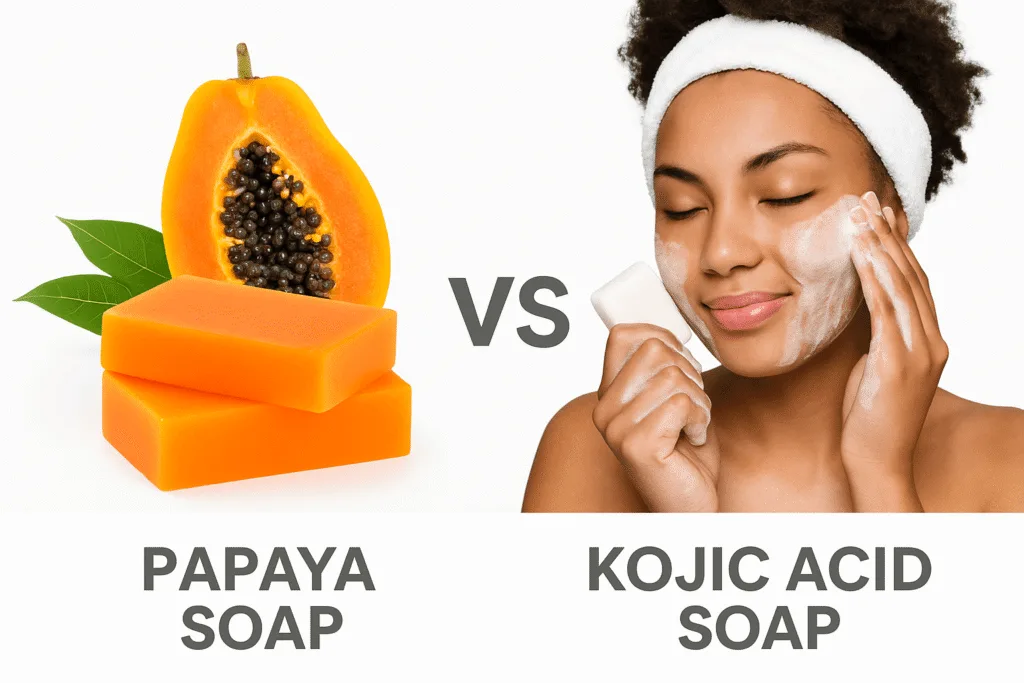🔍 Quick Summary: Which Soap Suits You?
If you’re deciding between Papaya Soap Vs Kojic Acid Soap, here’s the quick breakdown:
| Feature | Papaya Soap | Kojic Acid Soap |
|---|---|---|
| Key Ingredient | Papain enzyme (from papaya) | Kojic acid (byproduct of rice fermentation) |
| Main Benefit | Exfoliates & brightens skin | Lightens pigmentation & dark spots |
| Suitable Skin Type | Normal to oily | Oily, acne-prone, and pigmented skin |
| Common Use | Acne scars, uneven tone | Hyperpigmentation, melasma, sun spots |
| Gentleness | Mild | Moderate (can be drying) |
Explore our Papaya Soap to see if it’s right for your skin goals.
What Are These Soaps Made Of?

Ingredient Comparison Table
| Component | Papaya Soap | Kojic Acid Soap |
| Active Ingredient | Papain enzyme from papaya fruit | Kojic acid from fermented rice/fungi |
| Supportive Agents | Coconut oil, glycerin, vitamin E | Glycerin, coconut oil, tea tree extract |
| Scent | Mild fruity (natural papaya) | Neutral to medicinal |
| Additives | Often includes herbal extracts or honey | May include fragrance and preservative |
Papaya Soap
This cleansing bar contains papain, an enzyme found in papaya fruit. It gently removes dead skin cells and can help improve clarity and brightness.
Kojic Acid Soap
Derived from fermented rice or fungi, kojic acid inhibits melanin production and is often used to treat pigmentation issues such as melasma and age spots.
According to the National Center for Biotechnology Information (NCBI), kojic acid is considered a safe and effective ingredient for skin lightening when used correctly.
How Do They Treat Acne and Scarring?
Papaya Soap
The Papaya Soap works by gently exfoliating dead skin and reducing pore blockage, a common cause of acne. Over time, this helps reduce the appearance of acne scars and improves overall skin tone.
Kojic Acid Soap
Kojic acid is more focused on melanin inhibition, which makes it effective against post-inflammatory hyperpigmentation. This can be particularly useful for those with darker acne marks.
Is One Better for Sensitive Skin?
- Papaya-based soaps are generally gentler and can be used on a daily basis.
- Kojic acid soaps, while effective, can be drying or irritating for some users, especially when overused.
Tip: Always patch-test either soap before fully integrating it into your skincare routine.
How Long Does It Take to See Results?
| Soap Type | Expected Results Timeline |
| Papaya Soap | 4–6 weeks for brighter skin & fewer scars |
| Kojic Acid Soap | 2–4 weeks for reduced dark spots |
Consistency is key. For optimal results, both soaps should be followed with SPF and moisturizer.
Are There Any Side Effects?
Papaya Soap
- Mild exfoliation
- Occasional dryness if overused
Kojic Acid Soap
- Increased sensitivity to sunlight
- Temporary redness or dryness
According to the American Academy of Dermatology, skin-lightening products should always be followed with sunscreen to avoid damage.
Which One Should I Choose?
If your concern is acne scars and gentle daily care, try our acne-fighting soap made from papaya. If you’re dealing with stubborn pigmentation, Kojic Acid Soap may deliver more noticeable lightening effects.
Still unsure? Here’s a quick guide:
- ✅ Choose Papaya Soap Vs Kojic Acid Soap for gentle exfoliation + tone correction
- ✅ Choose Kojic Acid Soap if your skin can tolerate it and pigmentation is severe
- ✅ Use Papaya Soap for long-term daily maintenance

Can They Be Used Together?
Yes, but not at the same time.
- Use Papaya Soap in the morning
- Use Kojic Acid Soap 2–3 times a week at night
And always follow with:
- Hydrating toner
- Sunscreen in the morning
- Gentle moisturizer
Internal Links
Summary
Papaya Soap Vs Kojic Acid Soap both offer valuable skincare benefits, but the choice depends on your specific needs and skin type. Whether you opt for the enzymatic exfoliation of papain or the melanin-suppressing properties of kojic acid, ensure you’re using each product correctly and consistently.